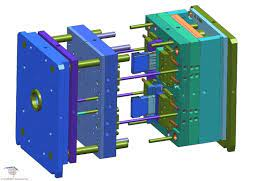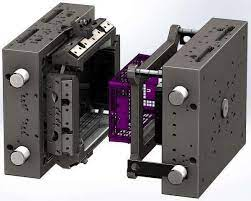4 Types of Injection Mold Design you should try in 2021
Plastic products are becoming more and more popular in daily life, from small items such as cups, bowls, food containers, and buckets to medical equipment, machinery components, and furniture. These are all products of plastic injection molding technology. Different types of injection mold design will produce different plastic products.
Technical requirements of Injection mold design
The process of designing a complete set of plastic injection molds. It requires the mold designer to understand the structure of the plastic injection mold, from there the process of processing the plastic injection mold and finally the production of plastic products. Moreover, it gives the best quality. Plastic injection molds need to meet the following technical requirements:
Ensure high accuracy in shape, size, no warping, high aesthetics
The details in the injection mold design must ensure rigidity, not be deformed, deviate from the position when operating, and must be able to withstand great pressure. Meet the glossiness criteria of both the mold cavity and the core to ensure the gloss of the product. The material common to make the mold must be easy to work but not subject to wear.
Classification of injection mold design
To design a complete set of plastic injection molds, a mold structure is important. Different products will require different mold textures. Plastic injection mold structure comes into types:
- 2-Plate Plastic Injection Mold
- 3-Plate Plastic Injection Mold
- Multi-layer Plastic Injection Mold
- Horizontal Latching Mold
2-Plate plastic injection mold design
The 2-plate plastic injection mold design is a type of plastic injection mold with a fairly simple structure, with a mold division divided into 2 parts: a fixed part and a movable part.
For a 2-plate plastic injection mold, when opening the mold to take the product out, the mold divider will open. At this time, the mold divides into 2 separate parts, the channel part and the product part on the same side.
Advantages of 2-plate mold
- Simple design, simple structure, less complicated
- Low cost, less processing material, faster-pressing cycle
- Cricket installation and repair
- Easy to take the glued tail out
Limitation of 2-plate mold
The automation process is not high; there is no self-adhesive tail cutting system, so labor is important for this stage. Therefore, it is not possible to optimize in mass production of products in large quantities such as 3-plate injection mold design.
The 2-plate plastic injection mold cannot be common in the processing of products that require high complexity.
Structure of 3-plate plastic injection mold
3-Plate plastic injection molds are structural molds with 3 main plates: fixed plate, movable plate, and glue tail holder plate. When opening the mold, there will be an opening to remove the product and an opening to take the glued tail out.
For 3-plate molds, the product and the glued tail are always separated during injection mold design.
Advantages of 3-plate mold
- The automation of the 3-plate mold is higher than that of the 2-plate mold
- It can automatically separate the glued tail.
- After opening the mold, the product and the glued tail will automatically separate.
- The 3-plate mold is effectively common for complex products requiring multiple nozzles.
Limitations of 3-plate mold
- Because of the complex mold structure, the 3-plate mold has a relatively high cost
- Although highly automated, it still requires a robot to get the glued tail out
- The structure of the channel is tough
- The process of assembling and maintaining the injection mold design is quite complex
- The injection pressure is reduced due to the long distance
- The cost of a 3-plate mold is high.
Injection mold design system:
It is responsible for liquefying and maintaining the temperature of the plastic material that comes into the mold cavity. The injection system also performs compression and degassing during mold injection.
Clamping system:
It performs the function of opening and closing the mold. Moreover, it creates a clamping force to keep the mold in the cooling process and push the plastic product out of the mold.
Multi-layer plastic injection mold
Structural multi-layer plastic injection molds usually have 3 mold assemblies in which a mold assembly is in the middle; on both sides is the mold cavity. When the mold is opened, 2 gaps will be created and now both spaces will allow the product to fall out.
When the production of a large number of products is important and to keep the product cost low, the multi-stage mold system is designed to reduce the clamping force of the machine. With a multi-stage mold system, we will get a push system on each face of the injection mold design, but this ejection system is extremely complicated.
Horizontal latch release mold
Normally, the product is pushed out of the plastic injection mold in the direction of opening and closing the mold. However, for products with horizontal holes or horizontal recesses, pushing the product will not be possible.
To get the product out of the mold, we need to pull out the horizontal hollows or horizontal holes to get the product out of the mold. That’s why we call it a horizontal latching mold.
The release of the horizontal pin is easy to do by using the opening motion of the mold through the use of a bevel pin or by using a hydraulic cylinder. It is to create a horizontal movement independent of the opening of the mold.
Basic criteria in evaluating injection mold design
The injection mold design technology common in mold manufacturing offers outstanding advantages, creating a wide range of products, shortening the lead time. On the other hand, mold technology meets the requirements of product diversity and complexity.
Manufacturing enterprises with modern technological equipment and lines all need to use quality molds, thereby improving the quality of finished products and improving production efficiency. Mold processing is a high-tech auxiliary industry; it requires many strict requirements on equipment, production processes, and human factors.
Modern machinery and equipment system
Injection mold design manufacturing includes many stages with high accuracy, requiring complex machining, so it requires very expensive investment in machinery and equipment. In which, CNC machines with high processing speed, high accuracy, come to automate and measure accurately.



